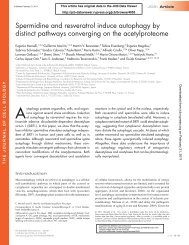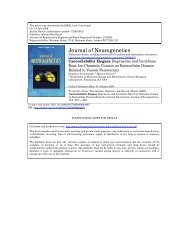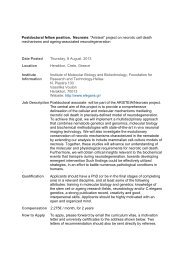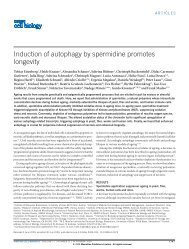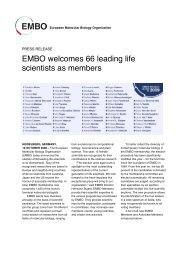- Page 1: Abstracts of papers presented at th
- Page 4 and 5: The meeting was funded in part by E
- Page 6 and 7: These abstracts should not be cited
- Page 8 and 9: CYFIP1, a Neuronal eIF4E‐BP, Link
- Page 10 and 11: POSTER ABSTRACTS Poster # [‐R(ed)
- Page 12 and 13: 030‐B Paracrine Pax6 Activity Reg
- Page 14 and 15: 058‐R Dynein Light Chain LC8 is a
- Page 16 and 17: 088‐R Spectraplakins ‐ Cytoskel
- Page 18 and 19: 121‐R Calmyrin1 Binds to SCG10 Pr
- Page 20 and 21: 18.00 ‐ 18.15 Non Hyperpolarizing
- Page 22 and 23: 10.00 ‐ 10.30 Neurotrophin Regula
- Page 24 and 25: SESSION 10 SYNAPTOGENESIS Chairpers
- Page 26 and 27: da F. Costa, L. 119 D'Adamo, P. 108
- Page 28 and 29: Lewallen, K. 145 Li, Y.‐H. 201 Li
- Page 30 and 31: Teuling, E. 141 Thiebes, K. 87 Thom
- Page 33 and 34: Cell Biology of the Neuron: Polarit
- Page 35 and 36: Cell Biology of the Neuron: Polarit
- Page 37 and 38: Cell Biology of the Neuron: Polarit
- Page 39 and 40: Cell Biology of the Neuron: Polarit
- Page 41 and 42: Cell Biology of the Neuron: Polarit
- Page 43 and 44: Cell Biology of the Neuron: Polarit
- Page 45 and 46: Cell Biology of the Neuron: Polarit
- Page 47 and 48: Cell Biology of the Neuron: Polarit
- Page 49 and 50: Cell Biology of the Neuron: Polarit
- Page 51: Cell Biology of the Neuron: Polarit
- Page 55 and 56: Cell Biology of the Neuron: Polarit
- Page 57 and 58: Cell Biology of the Neuron: Polarit
- Page 59 and 60: Cell Biology of the Neuron: Polarit
- Page 61 and 62: Cell Biology of the Neuron: Polarit
- Page 63 and 64: Cell Biology of the Neuron: Polarit
- Page 65 and 66: Cell Biology of the Neuron: Polarit
- Page 67 and 68: Cell Biology of the Neuron: Polarit
- Page 69 and 70: Cell Biology of the Neuron: Polarit
- Page 71 and 72: Cell Biology of the Neuron: Polarit
- Page 73 and 74: Cell Biology of the Neuron: Polarit
- Page 75 and 76: Cell Biology of the Neuron: Polarit
- Page 77 and 78: Cell Biology of the Neuron: Polarit
- Page 79: Cell Biology of the Neuron: Polarit
- Page 83 and 84: Cell Biology of the Neuron: Polarit
- Page 85 and 86: Cell Biology of the Neuron: Polarit
- Page 87 and 88: Cell Biology of the Neuron: Polarit
- Page 89 and 90: Cell Biology of the Neuron: Polarit
- Page 91 and 92: Cell Biology of the Neuron: Polarit
- Page 93 and 94: Cell Biology of the Neuron: Polarit
- Page 95 and 96: Cell Biology of the Neuron: Polarit
- Page 97 and 98: Cell Biology of the Neuron: Polarit
- Page 99 and 100: Cell Biology of the Neuron: Polarit
- Page 101 and 102: Cell Biology of the Neuron: Polarit
- Page 103 and 104:
Cell Biology of the Neuron: Polarit
- Page 105 and 106:
Cell Biology of the Neuron: Polarit
- Page 107 and 108:
Cell Biology of the Neuron: Polarit
- Page 109 and 110:
Cell Biology of the Neuron: Polarit
- Page 111 and 112:
Cell Biology of the Neuron: Polarit
- Page 113 and 114:
Cell Biology of the Neuron: Polarit
- Page 115 and 116:
Cell Biology of the Neuron: Polarit
- Page 117 and 118:
Cell Biology of the Neuron: Polarit
- Page 119 and 120:
Cell Biology of the Neuron: Polarit
- Page 121 and 122:
Cell Biology of the Neuron: Polarit
- Page 123 and 124:
Cell Biology of the Neuron: Polarit
- Page 125 and 126:
Cell Biology of the Neuron: Polarit
- Page 127 and 128:
Cell Biology of the Neuron: Polarit
- Page 129 and 130:
Cell Biology of the Neuron: Polarit
- Page 131 and 132:
Cell Biology of the Neuron: Polarit
- Page 133 and 134:
Cell Biology of the Neuron: Polarit
- Page 135 and 136:
Cell Biology of the Neuron: Polarit
- Page 137 and 138:
Cell Biology of the Neuron: Polarit
- Page 139 and 140:
Cell Biology of the Neuron: Polarit
- Page 141 and 142:
Cell Biology of the Neuron: Polarit
- Page 143 and 144:
Cell Biology of the Neuron: Polarit
- Page 145 and 146:
Cell Biology of the Neuron: Polarit
- Page 147 and 148:
Cell Biology of the Neuron: Polarit
- Page 149 and 150:
Cell Biology of the Neuron: Polarit
- Page 151 and 152:
Cell Biology of the Neuron: Polarit
- Page 153 and 154:
Cell Biology of the Neuron: Polarit
- Page 155 and 156:
Cell Biology of the Neuron: Polarit
- Page 157 and 158:
Cell Biology of the Neuron: Polarit
- Page 159 and 160:
Cell Biology of the Neuron: Polarit
- Page 161 and 162:
Cell Biology of the Neuron: Polarit
- Page 163 and 164:
Cell Biology of the Neuron: Polarit
- Page 165 and 166:
Cell Biology of the Neuron: Polarit
- Page 167 and 168:
Cell Biology of the Neuron: Polarit
- Page 169 and 170:
Cell Biology of the Neuron: Polarit
- Page 171 and 172:
Cell Biology of the Neuron: Polarit
- Page 173 and 174:
Cell Biology of the Neuron: Polarit
- Page 175 and 176:
Cell Biology of the Neuron: Polarit
- Page 177 and 178:
Cell Biology of the Neuron: Polarit
- Page 179 and 180:
Cell Biology of the Neuron: Polarit
- Page 181 and 182:
Cell Biology of the Neuron: Polarit
- Page 183 and 184:
Cell Biology of the Neuron: Polarit
- Page 185 and 186:
Cell Biology of the Neuron: Polarit
- Page 187 and 188:
Cell Biology of the Neuron: Polarit
- Page 189 and 190:
Cell Biology of the Neuron: Polarit
- Page 191 and 192:
Cell Biology of the Neuron: Polarit
- Page 193 and 194:
Cell Biology of the Neuron: Polarit
- Page 195 and 196:
Cell Biology of the Neuron: Polarit
- Page 197 and 198:
Cell Biology of the Neuron: Polarit
- Page 199 and 200:
Cell Biology of the Neuron: Polarit
- Page 201 and 202:
Cell Biology of the Neuron: Polarit
- Page 203 and 204:
Cell Biology of the Neuron: Polarit
- Page 205 and 206:
Cell Biology of the Neuron: Polarit
- Page 207 and 208:
Cell Biology of the Neuron: Polarit
- Page 209 and 210:
Dr. Christian Alfano INSERM U636, N
- Page 211 and 212:
Prof. Graeme W. Davis University of
- Page 213 and 214:
Prof. Zhigang He Harvard Medical Sc
- Page 215 and 216:
Dr. Bernhard Lohkamp Karolinska Ins
- Page 217 and 218:
Mr. Abhishek Shrikant Sahasrabudhe
- Page 219:
Dr. Med. Andreas Vlachos Goethe‐U
- Page 222 and 223:
Cell Biology of the Neuron: Polarit
- Page 224 and 225:
Cell Biology of the Neuron: Polarit
- Page 226 and 227:
NOTES:
- Page 228 and 229:
NOTES:
- Page 230:
NOTES:



